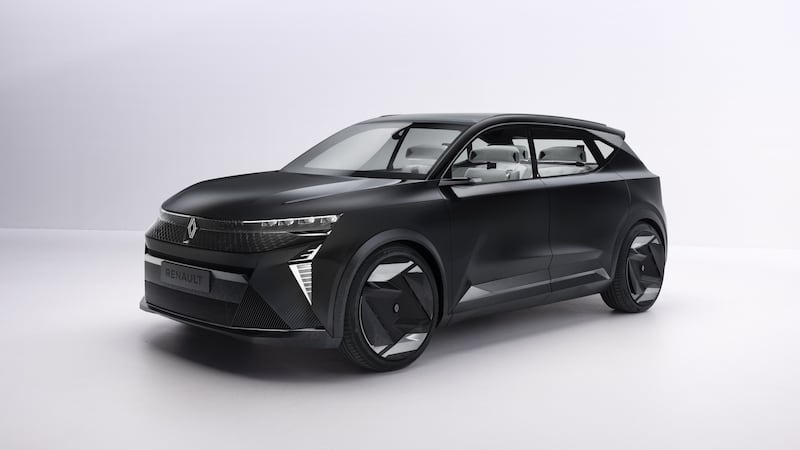The Scenic Vision concept at first glance could be mistaken for a cheeky homage to the award-winning Hyundai Ioniq 5.
It seems that a cross between a crossover and a hatchback is the new hot automotive design trend.
Closer examination reveals some specific details that make Renault’s Vision stand out from the Korean, however.


Renault’s vice president of design, Giles Vidal, showed us around his hybrid concept, explained its ethos and demonstrated its “responsive” cockpit.
First up, a reminder of how the Scenic is still a landmark model for the French brand. The first Scenic concept, revealed in 1991, proved to be a vital tool that helped deliver a popular compact MPV to the market. Buyers have long since fallen out of love with the MPV in favour of SUV styling, but even the once bankable SUV-look is evolving and who knows what will be in fashion in 2024, when the next generation Scenic is launched?
So what of this future model? The concept holds some significant clues.
Renault’s Vision is a hybrid, but perhaps is better described as an EV with a range extender. A French-made rear-mounted 160kW (214hp) electric motor, free of rare earth elements, powers the rear wheels. It gets electricity from a 40kWh rechargeable battery pack mounted under the floor (by 2024 the pack will be made in the French “ElectriCity” Gigafactory).
The battery when depleted gets an additional charge from a hydrogen engine under the bonnet. At least in this concept. It has a modest fuel tank (2.5kgs) which is made with carbon fibre produced from paper-industry waste, and delivers about 250km additional range. This engine produces 15kW (20hp) acting as an electrical generator only, and never turns the wheels. Vision has a range of about 750km-800km, with hydrogen refuelling taking five minutes.
In reality, the next generation Scenic in showrooms may look like this, but it will have a combustion engine under its bonnet.
The fact there is a vice president for group sustainability at Renault shows how the motor industry is changing. It wasn't so long ago it would have been more likely to come across an auto industry vice president for drinking Scotch and smoking cigars.
Cléa Martinet is charged with cleaning up the French car brand’s eco footprint. |She talked us through some prominent features while taking enormous pride in how the sourcing of materials is evolving to reduce its carbon footprint.
The most obvious use of recyclables is on show the minute you open the door of this Scenic concept car. The leather-free interior features futuristic white seating made entirely from polyurethane. The frame, fabric and even the tread used to stitch the seats together are made with fully recycled material and are themselves completely recyclable.
The seat materials are also pigment-free. Renault has a partnership with Airbus and recycled carbon fibres from the aeronautical industry have been used to tint the car's exterior paint. The interior's roof paint gets its colour from urban particulate pollution – that's soot to you and me. There's something rather apt that motorists should end up with cabin roofline coloured by soot.
The cabin floor is made using hard and durable tiles, laid in a similar way to a domestic ceramic floor, composed of 45 per cent recycled plastic milk bottles and 55 per cent old plastic pipes.
The Hepa purifier ensures air reaching the cabin is cleaned. You can observe the process in action on the driver’s door panel, a fine example of some of Vision’s overt technology. There is plenty of shy-tech hidden away too.
Distraction is a big issue for safety and Renault wants to minimise its effect through some great innovations. The lower part of the windscreen where it meets the dashboard is a giant head-up display.
This uses a wide field of vision to offer up driving and safety advice via the car’s cameras and sensors. The cabin seats feature head restraints with integrated loudspeakers and microphones, so not only can each occupant listen to whatever sound source they wish without disturbing others, they can also choose to have conversations with one or more occupant at near whisper level thanks to amplification.
A particularly interesting safety feature is a newly developed seat-mounted Cocoon airbag system. When deployed in a collision it embraces the passenger in a hug. This system, Renault believes, could do away with the need to mount airbags in the car’s architecture, freeing up space, saving money and potentially saving lives.
Much to the chagrin of privacy advocates, no doubt, the Scenic has facial recognition. This is how it unlocks. It then uses this identification system to set the car’s primary and secondary controls to the specific recognised driver. In-built AI will also predict what you may need and will adjust or suggest various settings from time to time.
The cabin features an abundance of small screens, each with different control functions that make a refreshing change from the large centre touch screen displays in today’s cars.
Renault predicts the revolution in the auto sector “will be more than complex: it will be total”. As part of the company’s plan for Scenic, it aims to have a 75 per cent smaller carbon footprint than a conventional vehicle and is a sustainability showcase for Renault.
How many will make it through to production remains to be seen, but the French car brand is eager to send out the right signals about the future of the Scenic model and the company’s direction as well.











